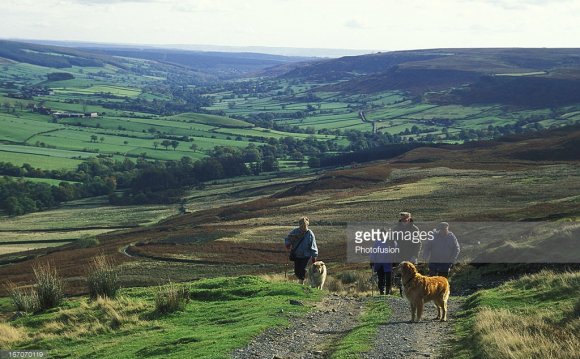
 Now a peaceful, rural dale in the heart of the National Park, in the nineteenth century Rosedale was part of industrial Yorkshire, with its ironstone mines, kilns and even a moorland railway. This fabulous 7½-mile circuit takes you from pretty Rosedale Abbey village through rolling valley farmland and into Rosedale itself, bringing you back along the old railway track past the impressive ruins of the old roasting kilns. From the railway, you get superb views of Rosedale – it’s very definitely a walk for a clear day.
Now a peaceful, rural dale in the heart of the National Park, in the nineteenth century Rosedale was part of industrial Yorkshire, with its ironstone mines, kilns and even a moorland railway. This fabulous 7½-mile circuit takes you from pretty Rosedale Abbey village through rolling valley farmland and into Rosedale itself, bringing you back along the old railway track past the impressive ruins of the old roasting kilns. From the railway, you get superb views of Rosedale – it’s very definitely a walk for a clear day.
Walk info
Great for: more than a stroll, big-sky views, history buffs Length: 7½ miles (12km) Time: 5 hours Start/Finish: Rosedale Abbey village green Grid Ref: SE 725 960 OS Map: Ordnance Survey OL26 Refreshments: Rosedale Abbey and Dale Head Farm Toilets: Rosedale Abbey villageAbout this walk
The route follows minor roads and farm lanes for short periods, and passes through farmyards and farm outbuildings. There are lots of gates (and one stile) en route. On the return, please do not explore the ruined kiln buildings you pass on the track, as parts of this old industrial area are dangerous. Also note that the railway route is exposed, and it can be windy and cold in winter.
Please note, you must keep your dog on a lead on the old railway track. On other parts of the walk, please keep your dog under control at all times, and always on a lead near livestock – it's likely that you will encounter livestock on most of the lower parts of this walk.
The moorland railway
Look for the line of the railway, which runs along the edge of the dale, high on the valley sides. It was an impressive feat of engineering, built in the 1860s and winding 14 miles over the moors, across difficult terrain, from Bank Top in Rosedale to Battersby Junction (near Great Ayton). At Rosedale, the railway branches into two levels – the upper line led to the mines above the kilns while the lower one (the one you walk on) served the kilns themselves. Once the iron ore had been processed, it was taken out of the valley by rail and on to County Durham and, later, Middlesbrough (with coal from County Durham coming the other way, to use in the kilns).
Mines, kilns and cottages
From 1855 until 1926 Rosedale rang with the sound of the Victorian industrial age. The valley was transformed with the opening of the ironstone mines, not least by the building of giant roasting kilns, where the miners roasted (or 'calcined') the iron ore to reduce its weight for transportation and remove impurities. Vast quantities of ore were tipped into the kilns from the railway line above, mixed with coal and then set alight.
A huge workforce was needed and the population of Rosedale increased rapidly to nearly 3000 people – more than ten times what it is today. Terraced houses in the dale were built for the miners, while the railwaymen occupied homes closer to the mines – you can still see their ruined remains.
YOU MIGHT ALSO LIKE












